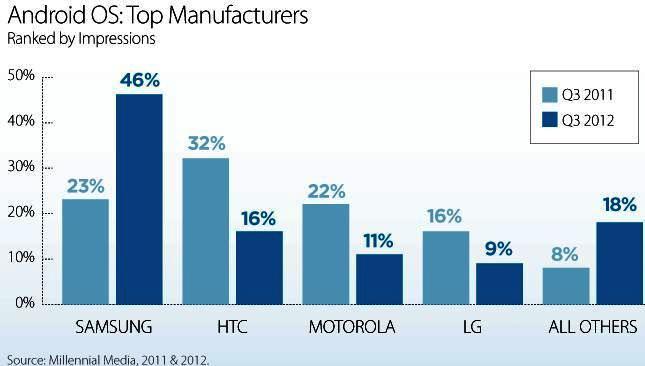In 2012, smartphone and Tablet have revolutionized entire global trend. A lot of innovations has been seen in the whole mobile ecosystem this year. At the time, manufacturers, advertisers, developers and even carriers are looking for monetizing their business on the mobile platform in order to generate more dollars. This year, the fight in smartphone segment was mainly among two major mobile platforms–Android and iOS.
Android has shown an unprecedented growth in the last couple years. Now, 75% of smartphones shipped in Q3 this year were powered by Android OS. Last year, in South-East Asia region, Android showed off an incredible 1000% Y/Y growth in sales. More importantly, China is now the world’s largest Android market, accounting for one-third of its entire market share. In comparison, Android’s second largest market—the U.S.— is currently accounting for just 11% of its overall share. It’s also expected that the platform (Android) could account for at least one out of every two mobile phone shipped in 2013.
In the prevalence of Android OS, Samsung is playing pivotal role. The company has always been a major Android player in the market. In Q3 2011, Samsung held just 23% of total Android impression, while in Q3 2012, the company’s market share doubled to 46% of entire Android market share. The south Korean electronic company is now 30% ahead of its nearest Android’s hardware partner–HTC–in terms of overall Android market share.
Until Q3 2011, HTC led Android market with 32% share, but it’s now second popular vendor (Android’s). On the other hand, Motorola and LG have seen strong downfall, their share fell from 22% and 16% in 2011 to 11% and 9% respectively.
Despite the economic downturn, the global smartphone market is on the rise in terms of shipments. However, the profit margin on the devices (manufacturer’s) has gradually been declining over past few years due to intense competition in smartphone space. At present, a significant number of smartphone is available in the market at very affordable price target. An intensifying competition in the segment has compelled even premium vendor like Apple to lower down its profit margin on iPhones.
Apparently, this time, consumers are more willing to own both low-end as well as high-end smartphones, and Samsung has made stronghold in both the segments. It’s estimated that around 786 million smartphone devices were sold this year–which also includes the figure of Android devices shipped by non-certified Android vendors in China–, representing a 45% Y/Y growth.
The Chinese smartphone market has seen 85% Y/Y growth in 2012. In China, Apple has reportedly to sell more than 2 million units of iPhone 5 during its opening weekend. It’s well known that China is second largest smartphone market for Apple, but the company is quite behind of Samsung in terms of market share in the country. In China, Apple had just 5% market share in Q3 2012, struggling at sixth notch. In comparison, Samsung is leading with 14% market share in China, followed by Lenovo.
Also in the U.S., Samsung dominates with more than 26% market share as of Q3 2012, followed by Apple and LG with 17.8% and 17.6% respectively. In terms of OS market share, Google’s Android OS unilaterally dominated with 53.6% market share in Q3 2012, while Apple’s iOS had just 34.3% market share in the same quarter.
Of course, Android is most popular mobile OS in the world, and Samsung is leveraging on its popularity. It’s pretty much clear that Smartphone market in the U.S. are on the way to reach saturation, and vendors are now looking to extend their business in the emerging markets like China and India. In India and China, Samsung has already made its grasp by offering both affordable as well as premium smartphones.


